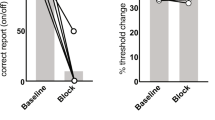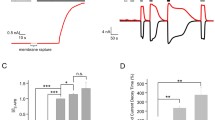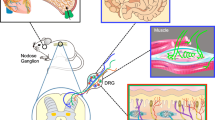Abstract
Pressure-induced vasodilation (PIV) delays the decrease in cutaneous blood flow produced by local application of low pressure to the skin, a physiologically appropriate adjustment of local vasomotor function. Individuals without a normal PIV response have a high risk of ulceration. Here we demonstrate that acid-sensing ion channel 3 (Asic3) is an essential neuronal sensor for the vasodilation response to direct pressure in both humans and rodents and for protecting against pressure ulcers in mice.


Similar content being viewed by others
References
Allman, R.M. N. Engl. J. Med. 320, 850–853 (1989).
Lyder, C.H. J. Am. Med. Assoc. 289, 223–226 (2003).
Reddy, M. et al. J. Am. Med. Assoc. 300, 2647–2662 (2008).
Fromy, B., Merzeau, S., Abraham, P. & Saumet, J.L. Br. J. Pharmacol. 131, 1161–1171 (2000).
Fromy, B. et al. J. Invest. Dermatol. 130, 849–855 (2010).
Koïtka, A. et al. Diabetes 53, 721–725 (2004).
Waldmann, R. et al. J. Biol. Chem. 272, 20975–20978 (1997).
Waldmann, R., Champigny, G., Bassilana, F., Heurteaux, C. & Lazdunski, M. Nature 386, 173–177 (1997).
Drew, L.J. et al. J. Physiol. (Lond.) 556, 691–710 (2004).
Arnadóttir, J. & Chalfie, M. Annu. Rev. Biophys. 39, 111–137 (2010).
Deval, E. et al. Pharmacol. Ther. 128, 549–558 (2010).
Price, M.P. et al. Neuron 32, 1071–1083 (2001).
Page, A.J. et al. Gut 54, 1408–1415 (2005).
Molliver, D.C. et al. Mol. Pain 1, 35 (2005).
Deval, E. et al. EMBO J. 27, 3047–3055 (2008).
Jones, N.G., Slater, R., Cadiou, H., McNaughton, P. & McMahon, S.B. J. Neurosci. 24, 10974–10979 (2004).
Immke, D.C. & McCleskey, E.W. Nat. Neurosci. 4, 869–870 (2001).
Allman, R.M., Goode, P.S., Burst, N., Bartolucci, A.A. & Thomas, D.R. Adv. Wound Care 12, 22–30 (1999).
Wultsch, T. et al. Pain 134, 245–253 (2008).
Deval, E. et al. J. Neurosci. 31, 6059–6066 (2011).
Diochot, S. et al. EMBO J. 23, 1516–1525 (2004).
Diochot, S., Salinas, M., Baron, A., Escoubas, P. & Lazdunski, M. Toxicon 49, 271–284 (2007).
Voilley, N., de Weille, J., Mamet, J. & Lazdunski, M. J. Neurosci. 21, 8026–8033 (2001).
Dubé, G.R. et al. Pain 117, 88–96 (2005).
Jones, N.G., Slater, R., Cadiou, H., McNaughton, P. & McMahon, S.B. J. Neurosci. 24, 10974–10979 (2004).
Costa, R. et al. Br. J. Pharmacol. 154, 1094–1103 (2008).
Demiot, C. et al. Diabetes 55, 1478–1483 (2006).
Sigaudo-Roussel, D. et al. Diabetes 53, 1564–1569 (2004).
Fromy, B., Abraham, P. & Saumet, J.L. Brain Res. Brain Res. Protoc. 5, 198–203 (2000).
Fromy, B., Abraham, P. & Saumet, J.L. Brain Res. 811, 166–168 (1998).
Potter, C. & Harris, A.L. Cell Cycle 3, 164–167 (2004).
Wykoff, C.C. et al. Cancer Res. 60, 7075–7083 (2000).
Acknowledgements
We would like to thank the subjects who participated in this study. We thank C. Viart-Ferber, A. Josset-Lamaugarny, G. James and N. Plèche (AnexPeau facility, Lyon) for helpful assistance in human and rodent studies. We are very grateful to S. Diochot and E. Deval (CNRS UMR 7275) for providing APETx2 and knockout mice, to P. Inquimbert, V. Friend (CNRS UMR 7275) and N. Gadot (Anipath facility, Lyon) for histological studies, and to R. Buttin and D. Katz for technical support for Perimed equipment. We also thank Fondation pour la Recherche Médicale and Prevention Education Recherche Soins Escarres for financial support.
Author information
Authors and Affiliations
Contributions
B.F., J.L.S. and M.L. conceived of and designed the experiments, analyzed the data, and contributed to writing and editing the manuscript; B.F. performed the experiments; E.L. and D.S.-R. contributed to discussions and provided tools important for completion of the work.
Corresponding authors
Ethics declarations
Competing interests
The authors declare no competing financial interests.
Supplementary information
Supplementary Text and Figures
Supplementry Figures 1–7 and Supplementary Methods (PDF 679 kb)
Rights and permissions
About this article
Cite this article
Fromy, B., Lingueglia, E., Sigaudo-Roussel, D. et al. Asic3 is a neuronal mechanosensor for pressure-induced vasodilation that protects against pressure ulcers. Nat Med 18, 1205–1207 (2012). https://doi.org/10.1038/nm.2844
Received:
Accepted:
Published:
Issue Date:
DOI: https://doi.org/10.1038/nm.2844
- Springer Nature America, Inc.
This article is cited by
-
Guizhi Decoction (桂枝汤) Inhibits Cholinergic Transdifferentiation by Regulating Imbalance of NGF and LIF in Salt-Sensitive Hypertensive Heart Failure Rats
Chinese Journal of Integrative Medicine (2020)
-
Inflammation-linked adaptations in dermal microvascular reactivity accompany the development of obesity and type 2 diabetes
International Journal of Obesity (2019)
-
Acid-sensing ion channels: dual function proteins for chemo-sensing and mechano-sensing
Journal of Biomedical Science (2018)
-
Targeted Acid-Sensing Ion Channel Therapies for Migraine
Neurotherapeutics (2018)
-
Ciliated neurons lining the central canal sense both fluid movement and pH through ASIC3
Nature Communications (2016)





